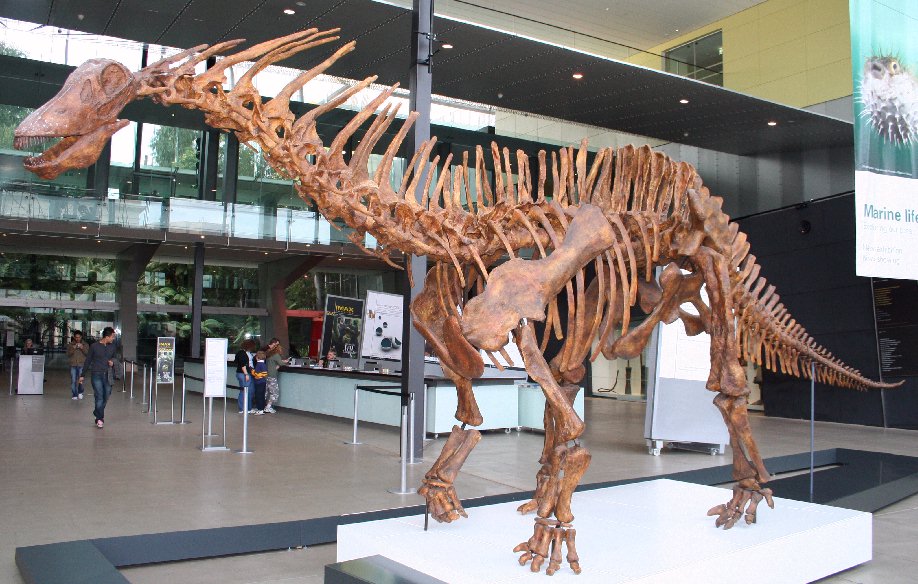- Amargasaurus
Taxobox|
name = "Amargasaurus"
fossil_range =Early Cretaceous

image_caption = "Amargasaurus" mounted skeleton cast in theMelbourne Museum foyer.
regnum =Animal ia
phylum =Chordata
classis =Sauropsida
superordo =Dinosaur ia
ordo =Saurischia
subordo =Sauropodomorpha
infraordo =Sauropoda
superfamilia =Diplodocoidea
familia =Dicraeosauridae
genus = "Amargasaurus"
species = "A. cazaui"
binomial = "Amargasaurus cazaui"
binomial_authority = Salgado & Bonaparte,1991 "Amargasaurus" (pronEng|əˌmɑrgəˈsɔrəs; "La Amarga lizard") is a
genus of dicraeosauridsauropod dinosaur from theEarly Cretaceous Period of what is nowSouth America . It was small for a sauropod, reaching 10meter s (33 feet) length. It would have been aquadrupedal herbivore with a long, lowskull on the end of a long neck, much like its relative "Dicraeosaurus ". However, this dinosaur sported two parallel rows of tall spines down its neck and back, taller than in any other known sauropod. These spines have been reconstructed supporting skin sails, but the "skin sail" hypothesis was rejected byGregory S. Paul in 2000.Paul, Gregory S. (2000) " [http://books.google.com/books?id=8oKsNcQ4j48C&pg=PA94&lpg=PA94&dq=amargasaurus+%22skin+sails%22&source=web&ots=n7JdzZsfNY&sig=EBZ7Smts8Mfs1BPSUZ_hqY9eM3o The Scientific American Book of Dinosaurs] ", p 94. St. Martin's Press. ISBN 0312262264.]Discovery and species
The name "Amargasaurus" was coined in
1991 by Argentinepaleontologist sLeonardo Salgado andJosé Bonaparte ,Salgado L & Bonaparte JF. (1991). Un nuevo sauropodo Dicraeosauridae, "Amargasaurus cazaui" gen. et sp. nov., de la Provincia del Neuquén, Argentina. "Ameghiniana" 28: 333-346. [in Spanish] ] because itsfossil remains were found alongside the La Amarga Arroyo in theNeuquén province of Argentina. La Amarga is also the name of a nearby town, as well as thegeologic formation the remains were recovered from. The word "amarga" itself is Spanish for "bitter," while "sauros" is Greek for "lizard." The one namedspecies ("A. cazaui") is named in honor of the man who discovered the site, Dr. Luis Cazau, ageologist with theYPF oil company, which at the time was state-owned.This site is located in the lower (older) sections of the
La Amarga Formation , which dates to theBarremian through earlyAptian stages of the Early Cretaceous Period, or around 130 to 120 million years ago.Paleobiology
"Amargasaurus" is known from a relatively complete skeleton from a single individual. This skeleton includes the back of the
skull , and allvertebra e of the neck, back, and hips, as well as a bit of the tail. The right side of the shoulder girdle is also known, as are the left forelimb and hind limb, and the left ilium, a bone of thepelvis .Vertebral spines
The most obvious feature of "Amargasaurus"' skeleton is the series of tall spines on the neck and back vertebrae. The spines are tallest on the neck, where they are paired in two parallel rows. These rows continue along the back, decreasing in height as they approach the hips. The lower back and sacral (hip) vertebrae feature only single spines, which are long but much shorter than those of the neck, comparable to other sauropods. These spines may have supported a pair of tall skin sails. Similar sails are seen in the unrelated dinosaurs "
Spinosaurus " and "Ouranosaurus ", as well as thepelycosaur s "Dimetrodon " and "Edaphosaurus ". There are a variety of hypotheses for the function of these sails, including defense, communication (for mating purposes or for simple species recognition), or temperature regulation. However, their true function remains unknown.Similar spines are found on the presacral vertebrae of "Dicraeosaurus" from
Africa , although not nearly as tall.Classification
"Amargasaurus" and "Dicraeosaurus" are united with the more recently discovered "
Brachytrachelopan " in the family Dicraeosauridae. Dicraeosaurids anddiplodocid sauropods are included in a group calledFlagellicaudata .Rauhut OWM, Remes K, Fechner R, Cladera G, & Puerta P. (2005). Discovery of a short-necked sauropod dinosaur from the Late Jurassic period of Patagonia. "Nature". 435: 670-672.] [Taylor MP & Naish D. 2005. The phylogenetic taxonomy of Diplodocoidea (Dinosauria: Sauropoda). "PaleoBios". 25(2): 1-7.]References
*Salgado, L. & Calvo, J.O. 1992. Cranial osteology of "Amargasaurus cazaui" Salgado and Bonaparte (Sauropoda, Dicraeosauridae) from the Neocomian of Patagonia. "Ameghiniana" 29: 337-346.
*Upchurch, P., Barrett, P.M, & Dodson, P. 2004. Sauropoda. In: Weishampel, D.B., Dodson, P., & Osmolska, H. (Eds.). "The Dinosauria" (2nd Edition). Berkeley: University of California Press. Pp. 259-322.
External links
* [http://ravenel.si.edu/paleo/paleoglot/files/Salgado&Bona_91.pdf English translation of original description (with figures)]
Wikimedia Foundation. 2010.
